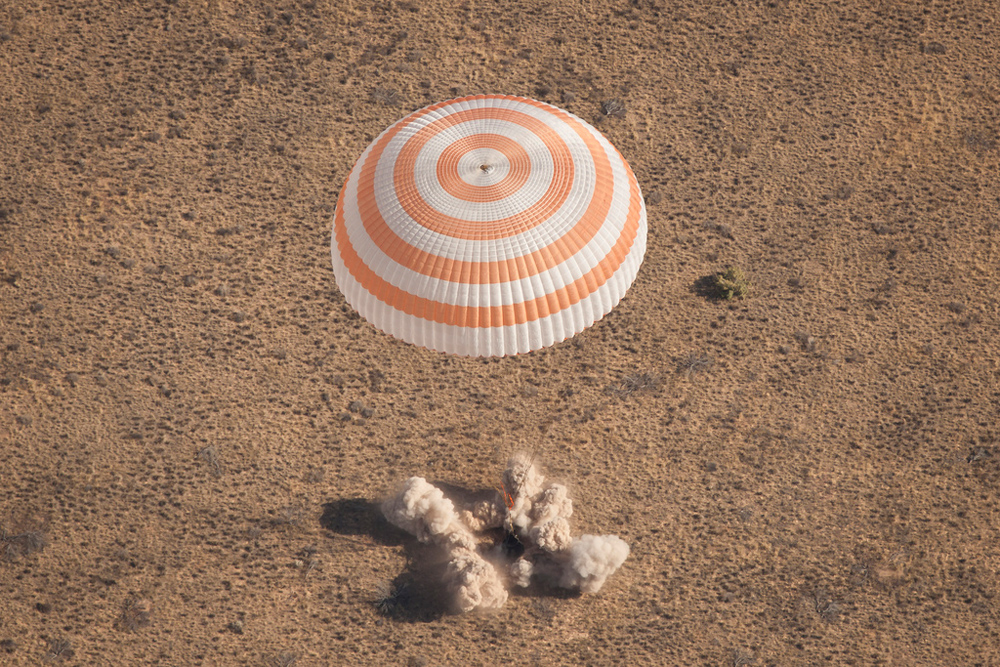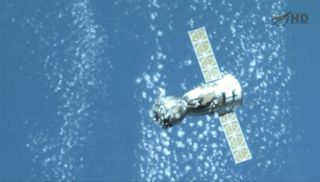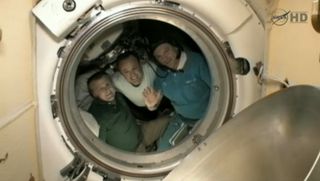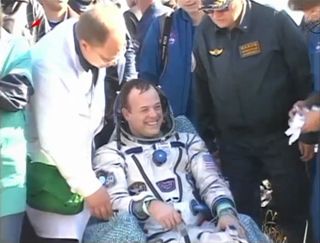Soyuz Space Capsule Lands Safely With US-Russian Crew

A Russian-built Soyuz space capsule landed safely back on Earth late Thursday (Sept. 15), returning an American astronaut and two cosmonauts home after more than five months in space.

The Soyuz TMA-21 spacecraft touched down at about 11:59 p.m. EDT (0359 GMT), though it was 9:59 a.m. Friday local time at their landing site on the steppes of Kazakhstan in central Asia.
Russia's Mission Control center in Moscow lost direct communications with the Soyuz during its descent through Earth's atmosphere, but the glitch apparently did not affect the spacecraft's normal landing operations.
"A bull's eye landing for the Soyuz TMA-21 spacecraft," said NASA spokeman Rob Navias during the agency's landing commentary. Earlier, Navias said a recovery team aircraft was able to contact the Soyuz crew and confirmed that its crew was doing well during the descent.
The spacecraft, which landed on its side, returned NASA astronaut Ron Garan and cosmonauts Andrey Borisenko and Alexander Samokutyaev back to Earth after 164 days in space. Three other space station residents stayed behind on the orbiting lab to complete their own months-long space trek. [Gallery: Building the International Space Station]
"It's been great sharing space with you," space station commander Mike Fossum of NASA told the departing crew just after the Soyuz undocked. "Safe journey and soft landing, my friends. Godspeed from the International Space Station."

Months-long space mission
Get the Space.com Newsletter
Breaking space news, the latest updates on rocket launches, skywatching events and more!
Garan and his Russian crewmates launched on April 4 just ahead of the 50th anniversary of the first human spaceflight by famed cosmonaut Yuri Gagarin on April 12, 1961. April 12 was also the 30th anniversary of NASA's space shuttle program.
The spaceflyers marked the 50th anniversary of the first American spaceflight (by Mercury astronaut Alan Shepard on May 5, 1961) from orbit. Their flight also included NASA's final two space shuttle missions — one in May and another in July — which delivered a major astrophysics experiment and vital supplies to the orbiting lab.
Throughout the mission, Garan posted stunning photos of Earth from space on Twitter under the name @Astro_Ron in order to share his experience with the public. Even on his last day in space, he managed to send his 86,000 followers a message. [Amazing Space Photos by Astronaut Ron Garan]
"Thanks 4 being w/me on this amazing journey," Garan wrote.
NASA retired its space shuttle fleet after 30 years of flight to make way for a new program aimed at deep space exploration using new capsule-based vehicles and a giant rocket called the Space Launch System, which the U.S. space agency unveiled on Wednesday.
Currently, NASA is relying on Russia's Soyuz rockets and spacecraft to launch astronauts into space, though the agency plans to use new privately built U.S. space taxis to send Americans into orbit once they become available.

New crew set to fly
Garan, Borisenko and Samokutyaev made up part of the Expedition 28 crew of the International Space Station, with Borisenko commanding the mission. On Wednesday, Borisenko turned control of the space station over to Fossum, who now leads the outpost's Expedition 29 mission.
Russian cosmonaut Sergei Volkov and Japanese astronaut Satoshi Furukawa also remain aboard the station. The three men will remain in space for the next three months.
Meanwhile, another three-man crew is preparing to launch toward the space station.
A Soyuz 28 spacecraft carrying NASA astronaut Daniel Burbank and cosmonauts Anatoly Ivanishin and Anton Shkaplerov is set to launch from Kazakhtan's Baikonur Cosmodrome on Nov. 14 and arrive at the space station two days later.
The Soyuz 28 spaceflight was delayed from a late September liftoff following the failed launch of a Russian Soyuz rocket carrying an unmanned space station cargo ship last month. A malfunction in the gas generator in the Soyuz rocket's third stage engine caused the failure. The Soyuz and its cargo ship, called Progress 44, ultimately crashed in Siberia.
Since the Progress 44 cargo ship launched on a Soyuz rocket similar to that which will carry the Soyuz 28 crew, NASA and Russia's Federal Space Agency agreed to ground all station-bound flights until the cause could be determined.
You can follow SPACE.com Managing Editor Tariq Malik on Twitter @tariqjmalik. Follow SPACE.com for the latest in space science and exploration news on Twitter @Spacedotcom and on Facebook.
Join our Space Forums to keep talking space on the latest missions, night sky and more! And if you have a news tip, correction or comment, let us know at: community@space.com.

Tariq is the Editor-in-Chief of Space.com and joined the team in 2001, first as an intern and staff writer, and later as an editor. He covers human spaceflight, exploration and space science, as well as skywatching and entertainment. He became Space.com's Managing Editor in 2009 and Editor-in-Chief in 2019. Before joining Space.com, Tariq was a staff reporter for The Los Angeles Times covering education and city beats in La Habra, Fullerton and Huntington Beach. In October 2022, Tariq received the Harry Kolcum Award for excellence in space reporting from the National Space Club Florida Committee. He is also an Eagle Scout (yes, he has the Space Exploration merit badge) and went to Space Camp four times as a kid and a fifth time as an adult. He has journalism degrees from the University of Southern California and New York University. You can find Tariq at Space.com and as the co-host to the This Week In Space podcast with space historian Rod Pyle on the TWiT network. To see his latest project, you can follow Tariq on Twitter @tariqjmalik.










